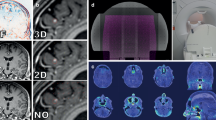Abstract
Dose expected volume histograms are a useful alternative to dose volume histograms in order to take into account computation uncertainty when prescribing, planning and reporting external beam radiation therapy. Due to the type B nature of computation uncertainties, a rectangular probability distribution was assumed in its definition. In the present work, the changes of dose expected volume histograms when using other recommended point dose uncertainty models are investigated. Results show that the choice of probability distribution, among the ones recommended for uncertainty modelling, has a small effect on the result. Thus, the standard uncertainty of point dose computations is the main parameter affecting dose expected volume histograms.
Similar content being viewed by others
References
International Commission on Radiation Units and Measurements. ICRU Report No. 50.Prescribing, recording, reporting, photon beam therapy. Washington, DC. 1994.
International Commission on Radiation Units and Measurements. ICRU Report No. 62.Prescribing, Recording and Reporting Photon Beam Therapy (Supplement to ICRU Report 50). Washington, DC. 1999.
Lefkopoulos, D., Ferreira, I., Isambert, A. et al.Présent et avenir de la radiothérapie guidée par l’image (IGRT) et ses applications posibles dans le traitement des cancers bronchides. Cancer Radiothérapie 11. 23–31. 2007.
Cho, B.C.J., van Herk, M., Mijnheer, B.J., et al,The effect of set-up uncertainties, contour changes, and tissue inhomogeneities on target dose-volume histograms. Med. Phys., 29 (10), 2305–2318, 2002.
Intensity Modulated Radiation Therapy Collaborative Working Group.Intensity-modulated radiotherapy: current status and issues of interest. Int. J. Radiat. Oncol. 51 880–914. 2001.
Ezzell, G.A., Galvin, J.M., Low, D. et al.Guidance document on delivery, treatment planning, and clinical implementation of IMRT: Report of the IMRT subcommittee of the AAPM radiation therapy committee. Med. Phys. Vol. 30, Issue 8. 2089–2115. 2003.
Venselaar, J., Welleweerd, H., Mijnheer, B.Tolerances for the accuracy of photon beam dose calculations of treatment planning systems. Radiot. Oncol. 60. 191–201. 2001.
Venselaar, J., Welleweerd, H.Application of a test package in an intercomparison of the photon dose calculation performance of treatment planning systems used in a clinical setting. Radiot. Oncol. 60. 203–213. 2001.
Cutanda Henríquez, F, Vargas Castrillón, S.A novel method for the evaluation of uncertainty in dose volume histogram computation. Int. J. Radiat. Oncol. Biol. Phys. 70 (4). 1263-1271. 2008.
IAEA. Technical Reports Series no. 430.Commisioning and Quality Assurance of Computerized Planning Systems for Radiation Treatment of Cancer. International Atomic Energy Agency. Vienna. 2004.
International Standards Organization.Guide to the Expression of Uncertainty in Measurement. Geneva. 1995.
Andreo, P., Burns, D.T., Hohlfeld, K. et al.Absorbed dose determination in external beam radiotherapy: an international Code of Practice for dosimetry based on standards of absorbed dose to water. IAEA Technical Report Series No. 398. International Atomic Energy Agency. Vienna. 2000.
Shaw, J.E. IPEMB Report 68.A guide to commissioning and quality control of treatment planning systems. Institute of Physics and Engineering in Medicine and Biology. York. 1994.
Born, E., Fogliatta-Cozzi, A., Ionescu, F. et al.Quality Control of Treatment Planning Systems for Teletherapy. Swiss Society for Radiobiology and Medical Physics. Recommendations no. 7. 1997.
Panitsa, E., Rosenwald, J-C., Kappas, C.Quality Control of Dose Volume Histogram Computation Characteristics of 3D Treatment Planning Systems. Phys. Med. Biol. 43 2807–2816. 1998.
Fraass, B, Doppke, K., Hunt, M., et al,American Association of Physicists in Medicine Radiation Therapy Committee Task Group 53: Quality assurance for clinical radiotherapy treatment planning. Med. Phys. 25 (10). 1773–1829. 1998.
Mayles, W.P.M., Lake, R., McKenzie, A., et al.Physics aspects of quality control in radiotherapy. IPEM Report No.81. The Institute of Physics and Engineering in Medicine, York, Great Britain, 1999.
Mijnheer, B., Olszewska, A., Fiorino, C. et al.Quality Assurance of Treatment Planning Systems. Practical Examples for Non-IMRT Photon Beams. ESTRO Physics booklet no. 7. European Society for Therapeutic Radiation Oncology. 2004.
Nederlandse Commissie voor Stralingsdosimetrie. Report 15.Quality assurance of 3-D treatment planning systems for external photon and electron beams. Practical guidelines for acceptance testing, commissioning and periodic quality control of radiation therapy treatment planning systems. NCS. 2006.
Van Dyk, J., Barnett, R.B., Cygler, J.E. et al.Commissioning and quality assurance of treatment planning computers. Int. J. Radiat. Oncol. Biol. Phys. 26(2). 261–273. 1993.
Author information
Authors and Affiliations
Corresponding author
Rights and permissions
About this article
Cite this article
Henríquez, F.C., Castrillón, S.V. The effect of the different uncertainty models in dose expected volume histogram computation. Australas. Phys. Eng. Sci. Med. 31, 196–202 (2008). https://doi.org/10.1007/BF03179344
Received:
Accepted:
Issue Date:
DOI: https://doi.org/10.1007/BF03179344




